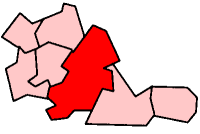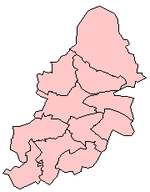Bordesley Green
| Bordesley Green | |
|---|---|
 South & City College Birmingham – Bordesley Green Campus | |
 Bordesley Green Bordesley Green shown within the West Midlands | |
| Population | 33,937 (Ward population in 2011) |
| • Density | 81.25 per ha |
| OS grid reference | SP105865 |
| Metropolitan borough | |
| Metropolitan county | |
| Region | |
| Country | England |
| Sovereign state | United Kingdom |
| Post town | BIRMINGHAM |
| Postcode district | B9 |
| Dialling code | 0121 |
| Police | West Midlands |
| Fire | West Midlands |
| Ambulance | West Midlands |
| EU Parliament | West Midlands |
| UK Parliament | |
Bordesley Green is an inner-city area of Birmingham, England about two miles east of the city centre. It also contains a road of the same name. It is also a ward in the formal district of Hodge Hill. Neighbouring areas include, Alum Rock, Saltley, Small Heath and Yardley.
Heartlands Hospital is located in the eastern part of Bordesley Green. The area is also served by Yardley Green Medical Centre and Omnia Practice.
Kingfisher Country Park covers the River Cole recreation grounds which are partially covered by the area's boundaries.
History
The name of this part of Birmingham is derived from an ancient area of demesne pasture, listed in early records dating back to 1285 as La Grene de Bordeslei. [1]
The area began to be built up in 1834, with scattered developments from Bordesley along Bordesley Green from the junction of Cattell Road and Garrison Lane as far east as Blake Lane. By 1906 urban development had spread eastwards as far as Blakesland Street and Mansell Road and included a fire station and police station, both of which survive, though the fire station no longer serves its original purpose and the police station is now a hostel for homeless people.[2][3]

Many roads in Bordesley Green were built not long after the Boer War at the end of the 19th century and were named to commemorate the hundreds of soldiers from Birmingham that died in that war.[4] Examples include Pretoria Road, named after the capital of the Boer republic of the Transvaal; Churchill Road, after Winston Churchill who fought in the Boer War, was captured but escaped; Botha Road, named after the Boer general who became the first prime minister of the Union of South Africa; and Colonial Road.[5]
Many late-Victorian and Edwardian houses remain in Bordesley Green and much of the area has physically changed changed little since then.
The area also features public art with the installation of Ondré Nowakowski's Sleeping Iron Giant, a large head lying on its side on a mound near the St Andrew's football ground.
Demography
In 2001, an estimated 31,343 people were living in the ward making it the second most populous ward, behind Sparkbrook.[6] This increased to 33,937 by the time of the 2011 Population Census. The ward has an area of 417.7 hectares resulting in a population density of 81.25 people per hectare.[7] Females represent 51.2% of the population, below the city average of 51.6% and the national average of 51.3%.
99.7% of residents lived in households, above the city average of 98.3%. The other 0.3% lived in communal establishments. The total number of occupied households in the ward was 9,350. This results in an average of number of people per household of 3.3, higher than the city of 2.5 and national average of 2.4. The majority of households are owner occupied (58%). 20.6% of occupied households are rented from Birmingham City Council, above the city average of 19.4%. 337 houses were identified as being vacant. Terraced houses built in the late 19th or early 20th century were the most common form of housing in the area at 54.4%, compared with the city average of 31.3% and the national average of 25.8%. At 25.4%, semi-detached houses were the second most common form of housing.
The area is an ethnically diverse community with ethnic minorities consisting of 71.1% of the population compared to 29.6% for Birmingham overall. 33.5% of the population was born outside of the United Kingdom, much higher than the city average of 16.5% and the national average of 9.3%. 62.2% of the population was of Asian origin, of which 50.5% were British Pakistanis. The proportion of Asian people in Birmingham is much lower at 19.5% and the proportion of Pakistani people is 10.6%. White British people represented 25.7% of the ward's population. There is a wide variety of languages spoken within the area such as Punjabi, Urdu, Mirpuri, Bengali, Pushto and Arabic with English being the most widely spoken language. The most dominant religion in the ward was Islam with 59.4% of the population stating themselves as Muslims, above the average for Birmingham of 14.3% and the national average of 3.1%. Christianity was the second largest religion in the ward with 27.1% of the ward's population stating themselves as Christians.
The ethnic minorities of Bordesley Green are particularly concentrated in the Victorian and Edwardian terraced houses, having emigrated to the area from the Commonwealth during the 1950s and 1960s.
The 25–44 age group represented the greatest portion of all age groups at 27.3%. At 22.2%, the 5–15 age group was the second largest. The proportion of the population that was of a pensionable age was 11.7%, below the city average of 16.7% and the national average of 18.4%. The proportion of people of a working age was 54.9%, below the city average of 59.8% and national average of 61.5%. The unemployment rate is 15.5%, higher than the city average of 9.5% and national average of 5%. 47.1% of the residents were identified as being economically active. Of the unemployed, 34.1% were in long term unemployment and 23.6% had never worked. 19.5% of the working population worked in the Wholesale & Retail Trade, Vehicle Repairs sector, followed by 19.3% of the working population working in the Manufacturing sector. The Birmingham Heartlands & Solihull Trust is the largest employer in the area, employing approximately 5,000 people. South Birmingham College is the second largest employer, employing around 850 people.[8]
Several hundred terraced houses around Bordesley Green dating from the late 19th and early 20th centuries were demolished in the early 1990s and new houses built on their site as part of a "New homes for old" initiative which allowed people to remain living in areas that their families had lived in for generations.
Politics
The Bordesley Green Ward was created in June 2004 out of the Small Heath and Sparkbrook wards. However the 2004 Council Election was marred by vote rigging by the Labour Party candidates, who were subsequently removed from the Council.
It is represented at the Birmingham City Council by three Labour councillor; Shafique Shah (Labour), Mohammed Aikhlaq (Labour) and Uzma Ahmed (Labour).[9]
Bordesley Green has adopted a Ward Support Officer with the current holder of the title being Tracey Arthurs.
Bordesley Village
Bordesley Green has an associated village, Bordesley Village, within its ward, offering considerably better housing. The village is often referred as a separate area, and attempts are being made to separate the two to distinguish the areas. The village is also home to the City's football team, Birmingham City FC, built before the village was established from an old gypsy encampment and scrap yard. Recently, the village has seen several additions, becoming the hub of the city's new car sales, with premium firms such as Mercedes Benz, Audi & Infiniti, as well as Volkswagen & Seat and many more including motorcycle firms Heine Gericke & Triumph. The village is also served by several small shops, such as newsagents, a pharmacy and has its own dentist and doctors surgery. The village also caters for the needs of shoppers, offering a Morrisons supermarket & fuel station and Iceland, as well as fashion outlets such as JD, Bank, Topshop and other shops such as Toys R Us, Poundland, B&M and many more national companies within walking distance of the village.
The Village concept in Bordesley Green was the first "Ideal Village" in England, built between 1908 and 1914 by Barry Parker and Raymond Unwin. The pair eventually went on to build Welwyn Garden City in Hertfordshire. The villages were a welcome relief to English cities at the time and the homes were built to high standards.
Daniels Road in Bordesley Green commemorates schoolteacher Francis Daniels. Originally from Ebley near Stroud, Daniels came to Birmingham in 1891 and soon saw the need to provide affordable social security for ordinary working people. With the Lord Mayor, Alderman William Kendrick as president and Daniels himself as general secretary, the Ideal Society was formed.
By 1910 the society had moved into housing provision and commenced the building of the Ideal Village at Bordesley Green, where Finnemore Road also commemorates an early chairman of the society, William Finnemore. The first houses to be built were in Drummond Road. The village, which was designed for artisan workers, has shops, a park and a school and a much lower density of housing than the nearby terraces.
St Paul's Mission, built in 1912 in Finnemore Road as a chapel of St Margaret's Ward End, was consecrated as a parish church in 1929. A new church was built c1970 in Belchers Lane behind the old, which was retained as the church hall. The church is now the centre of a community project embracing a number of different facilities and services.
In 1998 children from Bordesley Green Primary School discovered the origin of a badly damaged stone fountain in the Ideal Park which commemorates the rescue by a local boy of a drowning girl. On 7 May 1907 16-year-old cycle polisher, Harold Clayfield of 11 Ronald Road, jumped into a 5m deep clay pit at the junction of Belchers Lane and Bordesley Green to save 4-year-old, Florence Jones. The girl was saved, but non-swimmer Clayfield, drowned. His memorial was paid for by public subscription. Sadly Florence herself was to die only four years later as a result of playing with burning pieces of paper at her home in Green Lane.[10]
Skate Park
Bordesley Green has one skate park, known locally as the Pod. It is popular with mini BMX Rocker riders.
Bordesley Green Allotments
The historic Bordesley Green Allotments is a 25-acre site that is host to the Bordesley Green Forest garden[11] and in 2012 was the venue for the Birmingham Annual Gardening Show [12] which is normally held in Kings Heath Park.
Education
Primary schools
- Alston Junior and Infants Primary School
- Bordesley Green Junior and Infants Primary School
- Wyndcliffe Primary School
Secondary schools
Further education
- South and City College Birmingham – Bordesley Green Campus
Health
- Heartlands Hospital
- Yardley Green Medical Centre
- Omnia Practice
References
| Wikimedia Commons has media related to Bordesley Green. |
- ↑ "Placenames Gazetteer".
- ↑ "The old fire station in Bordesley Green".
- ↑ "Old police station in Bordesley Green".
- ↑ "Birmingham Boer War Memorial".
- ↑ "Birmingham History".
- ↑ Birmingham Economy: Population
- ↑ "Bordesley Green Ward Fact Sheet" (PDF).
- ↑ Birmingham Economy: Bordesley Green
- ↑ Council, Birmingham City. "Councillors by Ward: Bordesley Green | Birmingham City Council". Government of the United Kingdom. Retrieved 25 November 2017.
- ↑ "The Ideal Village". billdargue.jimdo.com.
- ↑ "Bordesley Green Forest Garden".
- ↑ "Birmingham Annual Gardening".
- 2001 Population census information: Ward profiles
- small heath medical practice
- Birmingham City Council: Bordesley Green Ward

